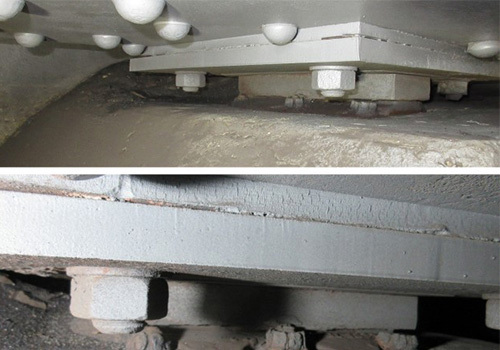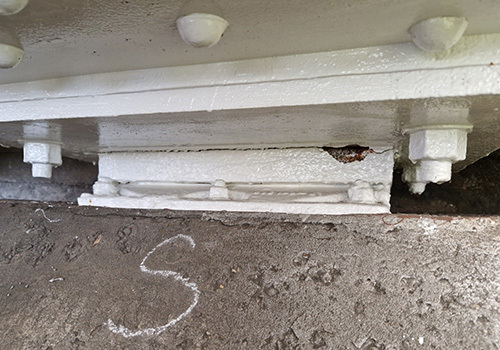Wandsworth Bridge closure FAQs
On this page
- What are the works?
- What are bridge bearings?
- Why does the bridge have to be closed?
- Why are these works happening now?
- Why were the works not completed whilst on site for phase 1?
- How long will the bridge be closed?
- How do I get across the river?
- What is in place for people with disabilities?
- Why are cyclists being forced to dismount to cross the bridge during the full closure?
- What is going to happen to Bus Routes 28, 295, C3 or N28 when they cannot cross the bridge?
- How is the impact of the closure being measured?
What are the works?
The works are to replace the bridge abutment bearings. This involves the hydraulic jacking (lifting) of the bridge structure, the removal of existing bearings, the installation of new bearings and lowering the bridge structure. As the road surface needs to be removed to lift the bridge, waterproofing works will be carried out before a new road surface is constructed and the carriageway re-opened.
What are bridge bearings?
Bridge bearings are designed to ensure that the loads are transferred between the superstructure and its supports and to enable movement and rotation. Wandsworth Bridge has 42 bearings. There are seven bearings in each abutment and the project will replace all 14 abutment bearings.


Some of the weight bearing parts of the bridge structure that need replacing.
Why does the bridge have to be closed?
In order to hydraulically lift the bridge without risk of damaging the structure, weight needs to be removed from the bridge. This can include live load including the weight of traffic and dead load, the weight of the structure and its components. To lift the bridge, we will be restricting traffic to ‘on foot’ only, removing the weight of the vehicles, along with the weight of the road surface itself.
Why are these works happening now?
The abutment bearings have seized and in situ repairs are not adequate enough to ensure we can maintain the existing weight restrictions on the bridge. With the movement function of the bearings restricted, temperature changes will put additional stress on the deck structure, causing potential further damage. The works are required to avoid the implementation of further weight restrictions on the bridge.
Why were the works not completed whilst on site for phase 1?
Phase 1 works included the removal of corrosion and application of a new protective paint system. Only when the corrosion was removed could a full detailed bearing inspection take place. Utilising the access arrangements for phase 1, the required inspections were carried out. The results indicated the abutments bearings had seized. The design work was then carried out. Unfortunately, the scope of works on phase 1 was due to complete after the school summer holiday period. It was felt a high priority to ensure the disruption of the bridge closure was during the school summer holidays when traffic tends to be significantly lighter.
How long will the bridge be closed?
The bridge will close on the night of Sunday, July 23rd for a period of approximately ten weeks. If bad weather does not affect the project the aim is to fully reopen the bridge at the end of September.
How do I get across the river?
Pedestrians will be able to cross Wandsworth Bridge during the closure. Cyclists will be asked to dismount and walk across the bridge. Motorists are likely to choose other river crossings, including those at Putney, Kew, Chiswick, Battersea and Chelsea with the impact on these crossings likely to be cushioned because overall traffic levels are around 20% lighter during the summer months compared to other times of the year.
To ensure better traffic flows over the borough’s river bridges, we will not permit any routine (non-emergency) roadworks on the approaches to these crossings.
What is in place for people with disabilities?
The 1.2m wide pedestrian corridors meet the minimum requirement for the provision of adequate width for wheelchairs, mobility scooters and push chairs, in a single direction. The arrangement will be one way, northbound on the western footpath and southbound on the eastern footpath, to maximise the use of the restricted space. There will be Marshals present on site to assist with the management of the movement across the bridge and we remind all users to consider their own and others safety.
Why are cyclists being forced to dismount to cross the bridge during the full closure?
Due to the constraints of additional weight on the bridge, during the closure, only a 1.2m wide corridor can be provided on either footway. As this is narrow, we will be requesting cyclists dismount for safety reasons, except for disabled cyclists who are using a cycle as their mobility aid. If walking pushing your cycle is impossible, painful, exhausting or dangerous to your health, you can keep riding across the bridge at walking speed. The marshals are there to assist at all time.
What is going to happen to Bus Routes 28, 295, C3 or N28 when they cannot cross the bridge?
All bus diversion information can be found on the TFL website.
How is the impact of the closure being measured?
We have installed six new traffic monitoring sensors and three new air quality sensors around Putney Bridge and will carry out ongoing monitoring of the impact of the bridge closure. We will ensure no other roadworks are carried out in Putney (except in emergencies) that could cause further disruption to traffic.